
An at times quite frightening and atmospheric film achieved by means of economy and simplicity
In a “future” 1973, the first manned expedition to Mars has been attacked and destroyed by an unknown life form which somehow later manages to stow away on the rescue ship. There is only one survivor from the initial ill-fated expedition: the leader, Col. Edward Carruthers. He is being brought back to earth under suspicion of having murdered his fellow astronauts! Will he have to face a firing squad for the crime of murder, or can he prove his claim that a Martian monster is to blame for the deaths of his crewmates?
Director: Edward L. Cahn
Screenplay: Jerome Bixby
Music composed by: Paul Sawtell, Bert Shefter
Producers: Edward Small, Robert E. Kent
Makeup: Paul Blaisdell
Narrated by Marshall Thompson
Cinematography: Kenneth Peach
Edited by Grant Whytock
Production company: Vogue Pictures, Inc.
Distributed by United Artists
Running time: 68 min.
Cast of Characters
Col. Ed Carruthers: (played by Marshall Thompson) Captain of the first expedition to Mars. All his crewmates were killed by the creature, but he is the one blamed for it.
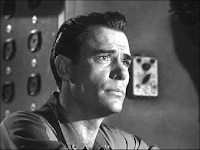 Col. Van Heusen: (played by Kim Spaldin) Captain of the rescue ship that is sent to rescue Ed Carruthers and his crew. Initially he is hostile towards Carruthers and manages to become infected by the alien stowaway.
Col. Van Heusen: (played by Kim Spaldin) Captain of the rescue ship that is sent to rescue Ed Carruthers and his crew. Initially he is hostile towards Carruthers and manages to become infected by the alien stowaway. Major John Purdue: (played by Robert Bice) He gets injured and spends most of the movie with a bandage on his head.
Major John Purdue: (played by Robert Bice) He gets injured and spends most of the movie with a bandage on his head. Lt. James Calder: (played by Paul Langton) Suffering a broken ankle and armed with only a blow torch, he becomes trapped between a couple of induction pumps by the monster.
Lt. James Calder: (played by Paul Langton) Suffering a broken ankle and armed with only a blow torch, he becomes trapped between a couple of induction pumps by the monster.
Bob Finelli (played by Richard Benedict) & Gino Finelli: (played by Richard Hervey) Brothers who fall victim to the creature.
 It!: (played by Ray Corrigan) A Martian life-form that stows away on the rescue ship and sets about picking off the crew one-by-one so that it can drain them of all their bodily fluids. The creature appears to be impervious to bullets, fire and radiation.
It!: (played by Ray Corrigan) A Martian life-form that stows away on the rescue ship and sets about picking off the crew one-by-one so that it can drain them of all their bodily fluids. The creature appears to be impervious to bullets, fire and radiation.
Movie Clip
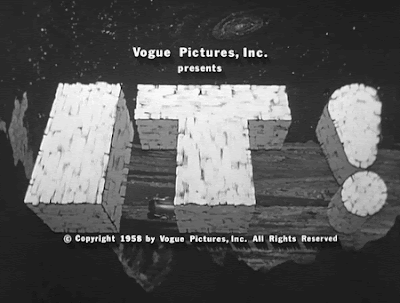
United States Space Command
Inquiry Into
The First Manned Mars Mission Incident
Of January _____ 1973
As events have since transpired, this is obviously no longer to be the case. Colonel Carruthers has been asked to attend this inquiry to place on the record all that he can recall about the incident beginning with his own mission on the surface of Mars through to the events involving the presence of the alien life form on the rescue vessel.
So, Colonel, we’ll begin with a shot of the site where your ship crash-landed on the Martian surface and we’ll add further graphics and ship photo & video-logs during the course of your testimony.
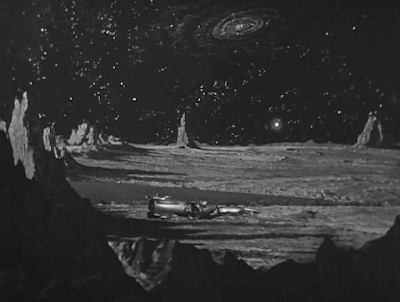
(Smartboard presentation of a panoramic shot of Mars where in the distance can be seen see a wrecked spacecraft.)
(I knew I would be) going back to face my superiors on earth in Washington. And perhaps there, too, I (would expect to) find another kind of death.”
“I (was) to spend the next 4 months with strangers, a crew of men and women who (had) but one single purpose...To see that I face a military firing squad.”
It wasn’t long after take-off that colonel Van Heusen challenged me about the fate of my 9 dead fellow crew members. I held fast to my story that the others had been killed by a mysterious creature on the surface, and that was why they could not find any bodies.
It was hard to even try to argue against Van Heusen’s unassailable logic. He pointed out to me something like, “The Challenge 141 cracks up in landing. You know you're marooned indefinitely on Mars until another ship is sent - If another ship is sent. You know the food and supplies aboard would last the entire crew only a year, but they'd last you 10 years, if the others were dead. Those people were killed by something.”
Van Heusen then showed me a skull they had recovered clearly bearing a bullet hole! He said to me, “There's only one kind of a monster that uses bullets.”


Thoughts then turned to how the creature got on board and why it was attacking us. “It opened the door to ‘C’ compartment” and its use of the air vents was certainly not a random action. It was obviously intelligent and “what is the usual reason an intelligent creature kills? It's hungry!”
Loud percussive sounds alerted us to the fact that the creature had triggered the explosives, and judging from the blood-curdling racket it was making, we suspected that it had been injured and not killed.

Mary Royce suddenly had a brainwave as she recalled the time when Gino made gas grenades. Apparently, at one time he had “joked about them, said if we ran into any dinosaurs on Mars, the grenades would take care of them.” We agreed that we would use them as a last resort.

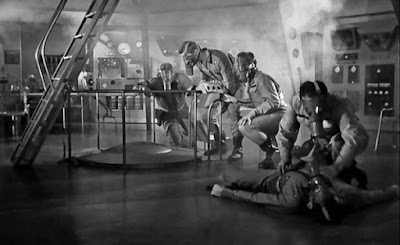
Water, blood, bone marrow, glandular secretion, moisture in the tissues...Every ounce of edible fluid in his body (was) gone. Probably through some osmosis process.”
This seemed to make sense seeing that “Mars is a world almost totally without water or oxygen. The creature's entire being (was) probably organized to feed in that manner. It (would’ve preyed) on smaller creatures, which in turn feed off the sand itself, converting their intake and hoarding it as water.”
To make matters worse, we had a pressing problem involving the injured Van Heusen’s condition. He was coming down with a fever from an infection that Mary Royce could not control.

Our attention was yet again drawn back to the presence of the creature by a series of loud banging noises coming from the deck under its control. We quickly ascertained that the creature was exploring the ship, looking for weaknesses and that it could get through the centre hatches. From its point of view, it was a simple choice of it having to kill us or starve. As far as we were concerned, we had to kill it or die.
While we considered our options, we realized “we could get around behind the creature by going out the control room emergency air lock, moving down the hull to the emergency air lock on the motor level. That would put us one level below (the creature).” We thought we “might be able to surprise it that way. If we knew what to surprise it with.”

The plan was a simple one. We planned to time it so that we could get to the motor level airlock at the time when the others would begin to make noise, “not a lot, just talk.” They would also be moving around “just enough to keep (the creature’s) attention away in case we (made) noise coming in below.” We hoped that this would be “the last attempt we (had) to make to kill the thing.”

Realizing that grenades, gas and bullets had thus far failed to stop the beast, we decided decide to rig a trap that would electrocute the creature with “enough voltage….to kill 30 human beings. The only drawback (was), the thing (wasn’t) human.” The plan unfortunately failed. I managed to escape back through an airlock but Calder broke his leg and found himself trapped in a corner armed with just a welder’s torch.

Despite establishing contact with Calder through the ship’s intercom, the gas bottle he was using only had a 3 hour supply remaining. Added to this, Ann Anderson informed us that Colonel Van Huesen would not survive without fresh blood supplies. The bacteria was attacking the bone marrow, resulting in a leukemia-like condition which could be fought with drugs, “but slowly. Too slowly.”
Another potential danger was that if the creature had attacked the induction pumps or the bank of control relays, we wouldn’t have been able to manoeuvre the ship or land it. We'd have just drifted right past earth towards interstellar space. We'd have just drifted forever.
Finelli, Major Purdue and I had the task of obtaining the supplies of fresh blood from the dispensary. In the meantime, Calder informed us that the creature was in the reactor room. In a move to trap the creature once and for all, the only door to the reactor room was automatically closed.
By now Colonel Huesen was in a bad state but despite his delirium, he made it out of his sickbed to activate the controls that opened the reactor shields in the hope of killing the creature. With enough radiation to kill 100 men and with the urgent need to get the blood supplies to our sick crewmates, we had to get out of the area fast.

As it turned out, the creature did manage to break out of the reactor room before the shield was opened. Tragically, Finelli was killed while Purdue and I managed to escape into the control room.

As the creature went on a rampage below, all we could do was ascend higher into the top level of the ship. Suddenly, I had an idea. I noticed that the oxygen consumption was way up: 40 percent over every previous maximum. The use of the gas grenades couldn’t account for it. Neither would a leak seeing that the pressure was OK. The creature itself provided the clue! It must’ve had enormous lungs from the thin air on Mars. If we were to let all the air out of the ship we could kill it.

I told Lt. Calder to crawl to the airlock and then I told the others to get into spacesuits. My plan was to destroy the creature by venting the atmosphere from the ship.
There was nothing to do but wait, nothing to do but see if the beast would reach us through the centre hatch. We could go no higher. We were in the top level of the ship. We all knew then “this is where either we die, or it dies.”
We watched as the creature made one last effort to break into our remaining refuge through the closed central hatch. As the hatch’s metal covering was seemingly being effortlessly punctured and peeled away, I triggered the venting process. Suddenly, as the ship began to exhale, its venting atmosphere clutched and clawed at us threatening to cast us out into the black infinity of space. Fortunately, the creature lost the battle for survival and with the air supply depleted and its enormous lungs starved of oxygen, it finally succumbed.
As to how exactly the creature had managed to board the ship in the first place? It is thought that it must've followed us back to the ship after I was picked up by the crew of Challenge 142. It must have then “climbed one of the fins just before take-off and got in through the open emergency hatch in ‘C’ compartment.”
General Steelbottom: Thank you Colonel for that most informative and illuminating testimony of what transpired in the depths of space. Your insights, together with the reports of your crew mates, will help to determine what will be our next steps in our exploration of outer space.
Of the 19 men and women who have set foot upon the planet Mars, only 6 have safely returned to us. Our latest venture on to the Martian surface has confronted us with “an alien and elemental life force” on a “planet so cruel, so hostile, that man may find it necessary to bypass it in his endeavour to explore and understand the universe.”
Ladies and gentlemen, there is now no question that "another name for Mars is…

It! The Terror from Beyond Space was distributed by United Artists on a double bill with Curse of the Faceless Man.
The film's premise seems to have served as an inspiration for screenwriter Dan O'Bannon's screenplay for Ridley Scott's film, Alien screened 20 years later. The film’s story itself may have been based on A.E. Van Vogt's, "Voyage of the Space Beagle."
Jerome Bixby who wrote the screen play for the film also had a hand in writing for such series as Star Trek, The Twilight Zone and also Fantastic Voyage.
The film was originally known as It! The Vampire from Beyond Space.
Principal photography took place over a two-week period during mid-January 1958.
This was the last film of actor Ray "Crash" Corrigan. Since he was not prepared to travel all the way to make up artist’s, Paul Blaisdell’s studio, no exact measurements of Corrigan's head could be made. The result was that there were final fit problems with the creature's head prop with Corrigan's chin sticking out through the monster's mouth, necessitating his chin having to be painted to look like a tongue!
There is an interesting plot reversal in which the story begins as the characters take-off from another planet and return to Earth bringing back with them an alien menace. This time it is not so much a case of human beings venturing out into space to confront hostile aliens or hostile aliens coming to earth to invade us. What we need to be fearful of are the kinds of dangers to our survival we ourselves carry about with us.
Colonel Carruthers insists on his innocence to the crew of the rescue ship, claiming that his original crew mates were killed by some unseen hostile alien presence. Of course, he cannot establish his innocence. A trial, court-martial and firing squad await him on his eventual return to earth. It’s truly amazing that an advanced civilization that can send a person to Mars and return him to Earth would still condone the use of capital punishment: a primitive and barbaric form of state-sanctioned murder! How many innocent people have been put to death in such a manner?
The small confining sets help to reinforce the claustrophobic tension and characters’ sense of entrapment, while the effective use of black & white photography helps to enhance the film’s dark and sinister mood. Note the use of shadow to suggest the creature’s aggression and menace.

You would no doubt have noticed that the women in It! The Terror from Beyond Space are not in the Ripley mold and do not fit in with the over-the-top 21 Century over-compensating “take that for the last fifty plus years” female action screen heroes. So what? It’s a part of history that can’t be air brushed out of existence. The women in this film without needing to faint, fall down or scream, had responsible positions as part of a space ship crew and made coffee and cleaned up the dishes after serving meals while the men charged about doing stuff. That was then and times change so we just need to get over it and move on instead of gleefully and smugly pointing out historical sexist stereotyping! How many women these days hold down successful careers yet still find themselves doing a disproportionate share of the once traditional female domestic chores in this oh so “enlightened” age!? The female characters in the film were not “Wonder Woman” types beating up evil men but were instead level-headed, reliable and responsible team players.
You can't help but laugh when the crew discharge firearms, rig grenades to explode and make ready to fire off a bazooka, all within the confines of a space ship in the vacuum of space! They obviously don’t build spaceships like they used to!
Notice that the planet is somehow associated with war and anger. It has also featured in many of the classic science fiction films featured on this blog and usually in association with an impending threat of invasion.
Rocketship X-M (1950)
Flight to Mars (1951)
Red Planet Mars (1952)
Invaders from Mars (1953)
War of the Worlds (1953)
Devil Girl from Mars (1954)
Conquest of Space (1955)
In some strange way it is as if the planet Mars has been trying to warn us to stay away. After all, only about 18 missions to Mars have been successful out of approximately 40 missions. Some were destroyed on launch, others were lost in space or on the planet. It is as if Mars is trying to tell us something!
And yet still we are drawn to our red-hued neighbour in space and long to have a human presence there. I believe we will be lucky if we manage to set foot on Mars any time before the middle of this century. You can be sure that with setting targets for such a mission as this, years or even decades will need to be added despite over-confident assertions that we presently have the technology to achieve such a goal. Many more steps will need to be taken in addition to the steps that have already been taken to help us better understand our neighbour and eventually get us to Mars.
Baby Steps Taken So Far:
1960s
The former Soviet Union:
1970s And 1980s


Failed Missions
Successful Missions
21st Century




To all those who rush out to sign up to be among the first colonists of Mars, take head of the sentiments expressed by one of the characters in the film:
Future missions to Mars will take months to get to the planet and will probably amount to buying a one-way ticket. Imagine being confined in space and then on Martian soil in a relatively small space for all that time with the same people for company. Tell me you wouldn’t get homesick after a while:
Hot luxuriant baths and showers instead of sponge baths; the smell of springtime instead of the stale stench of body odour; the invigorating effects of a walk in the fresh air instead of the mouth-drying and eye-irritating effects of ait-con & recycled air; the mental and emotional stimulation of civilised life as opposed to the soul destroying and psychologically damaging effects of isolation and virtual technological imprisonment.


You’d be standing on the surface of the fourth planet from the Sun and the second smallest planet in the solar system.”
If you decide to jump for joy, be careful because the Martian surface gravity is only 37% of the Earth’s. You can leap nearly three times higher than you would on Earth!
You would not be able to breathe without an oxygen tank due to the thin atmosphere composed primarily of carbon dioxide.
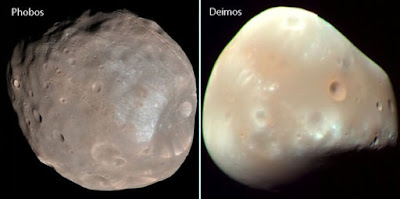
Look up and you might see two small moons: Phobos & Deimos.
You’d also see the Sun which appears about half the size as it does on Earth.
Rug up and keep warm since the surface temperatures range from -153 to 20 °C.

If you’d like to warm up with a spot of mountain climbing, there’s always the challenge of the tallest mountain in the solar system, Olympus Mons, a shield volcano, 21km high and 600km in diameter!
Staying outdoors might not always be a good option since Mars has the largest dust storms in the solar system that can last for months and cover the entire planet. Not to mention the extreme seasons due to the planet’s quite elongated elliptical orbital path around the Sun.
As for that dust! It gets into every nook and cranny if you’re not careful. The red colour that Mars is known for and named after when referred to as the “Red Planet,” is due to the rock and dust covering its surface being rich in iron.
On Mars, you’d have to wait longer for your next birthday seeing that a Martian year is the equivalent of 687 Earth days. Almost twice as long as an Earth year.
You’d get used to the days on Mars as a day lasts just 40 minutes longer than a day on Earth.
On the up-side, there are signs of liquid water on Mars. There’s water in the form of ice. There’s also trickling or flowing water on crater walls and cliffs particularly during summertime. I wouldn’t try to drink it I were you as it would be rather briny or salty. There’d be a need for a desalination process.

©Chris Christopoulos 2017
To make matters worse, we had a pressing problem involving the injured Van Heusen’s condition. He was coming down with a fever from an infection that Mary Royce could not control.


Realizing that grenades, gas and bullets had thus far failed to stop the beast, we decided decide to rig a trap that would electrocute the creature with “enough voltage….to kill 30 human beings. The only drawback (was), the thing (wasn’t) human.” The plan unfortunately failed. I managed to escape back through an airlock but Calder broke his leg and found himself trapped in a corner armed with just a welder’s torch.

Another potential danger was that if the creature had attacked the induction pumps or the bank of control relays, we wouldn’t have been able to manoeuvre the ship or land it. We'd have just drifted right past earth towards interstellar space. We'd have just drifted forever.
By now Colonel Huesen was in a bad state but despite his delirium, he made it out of his sickbed to activate the controls that opened the reactor shields in the hope of killing the creature. With enough radiation to kill 100 men and with the urgent need to get the blood supplies to our sick crewmates, we had to get out of the area fast.



There was nothing to do but wait, nothing to do but see if the beast would reach us through the centre hatch. We could go no higher. We were in the top level of the ship. We all knew then “this is where either we die, or it dies.”
As to how exactly the creature had managed to board the ship in the first place? It is thought that it must've followed us back to the ship after I was picked up by the crew of Challenge 142. It must have then “climbed one of the fins just before take-off and got in through the open emergency hatch in ‘C’ compartment.”
General Steelbottom: Thank you Colonel for that most informative and illuminating testimony of what transpired in the depths of space. Your insights, together with the reports of your crew mates, will help to determine what will be our next steps in our exploration of outer space.
Of the 19 men and women who have set foot upon the planet Mars, only 6 have safely returned to us. Our latest venture on to the Martian surface has confronted us with “an alien and elemental life force” on a “planet so cruel, so hostile, that man may find it necessary to bypass it in his endeavour to explore and understand the universe.”
Ladies and gentlemen, there is now no question that "another name for Mars is…
……… Death!"
Points of Interest

The film's premise seems to have served as an inspiration for screenwriter Dan O'Bannon's screenplay for Ridley Scott's film, Alien screened 20 years later. The film’s story itself may have been based on A.E. Van Vogt's, "Voyage of the Space Beagle."
Jerome Bixby who wrote the screen play for the film also had a hand in writing for such series as Star Trek, The Twilight Zone and also Fantastic Voyage.
The film was originally known as It! The Vampire from Beyond Space.
This was the last film of actor Ray "Crash" Corrigan. Since he was not prepared to travel all the way to make up artist’s, Paul Blaisdell’s studio, no exact measurements of Corrigan's head could be made. The result was that there were final fit problems with the creature's head prop with Corrigan's chin sticking out through the monster's mouth, necessitating his chin having to be painted to look like a tongue!
There is an interesting plot reversal in which the story begins as the characters take-off from another planet and return to Earth bringing back with them an alien menace. This time it is not so much a case of human beings venturing out into space to confront hostile aliens or hostile aliens coming to earth to invade us. What we need to be fearful of are the kinds of dangers to our survival we ourselves carry about with us.

MARS
Named after the Roman god of war and now often referred to as the “Red Planet. The ancient Greeks called the planet “Ares”, after their own god of war; while China’s astronomers called the planet ‘the fire star’ and ancient Egyptian priests referred to it as ‘the red one’. Even the Egyptian city’s name of “Cairo” is Arabic for “Mars” so named because the planet was apparently rising on the day the city was founded.Rocketship X-M (1950)
Flight to Mars (1951)
Red Planet Mars (1952)
Invaders from Mars (1953)
War of the Worlds (1953)
Devil Girl from Mars (1954)
Conquest of Space (1955)
1960s
The former Soviet Union:
- Mars 1 mission sent back data about Mars before contact was lost a few months after launch.
- Mars 2 reached Mars, but its rover crashed-landed on the surface.
- Mars 3 - 6 were partially successful,
- Mars 7’s lander never made it to the surface.
- In 1964 Mariner 4 flew by Mars and returned the first-ever images of the planet.
- Further successful Mariner fly-by missions returned images and data.

- The US spacecraft, Mariner 9 arrived during a planet-wide dust storm and successfully put itself into orbit. After the dust storm, it returned 7,329 images that revealed 85 percent of the surface of the planet including images of river beds, craters, flood plains, canyons, and volcanic features.

- In 1976, the U.S. put two Viking landers on the surface of Mars that communicated with Earth via their orbiters. Over several years, they supplied surface images, atmospheric data, and orbiter mapping.
- In 1988 the Soviets launched two Phobos Missions. Contact was lost with Phobos 1, while Phobos 2 entered Mars orbit and returned some data before contact was lost with the spacecraft.
Failed Missions
- In 1993 NASA’s Mars Observer mission failed due to a possible fuel leak.
- In 1996 Mars 96 failed at launch.
- In 1999 NASA’s Mars Climate Orbiter crashed to the Martian surface due to a metric-English measurement error.
- Also in 1999 NASA’s Mars Polar Lander crashed to the surface due to an equipment failure.
- NASA’s Mars Global Surveyor spent nearly 10 years mapping and imaging the planet from orbit.
- Mars Pathfinder mission became the first to set a rover down on the planet. It lasted for three months and was the first mission to drill into rocks to determine their composition.
21st Century
- NASA’s Mars Odyssey.

- European Space Agency’s Mars Express
- In 2004 The Mars Exploration Rovers “Spirit” and “Opportunity" began searching for evidence of past water on Mars. Amazingly “Spirit” lasted for about 7 years and Opportunity is still operational. Both rovers should have monuments erected in their honour for their endurance and for their discoveries about the surface of Mars, the existence of water and insights they have given us into the Martian weather and climate.
- In 2005 The Mars Reconnaissance Orbiter was launched and has mapped and imaged the planet at high resolution.
- Mars Phoenix landed on Mars and spent several months cataloguing conditions near the northern polar regions.
- Britain’s Beagle Rover made it to Mars, but failed upon landing.
- China’s Yinghuo-1 mission fell back to Earth after a launch failure.

- The U.S. Mars Curiosity rover has been returning images from the surface as well as detailed mineralogy of the rocks where it landed.

- In 2014, the Curiosity Rover discovered 'burps' of methane, which could indicate life or at least ancient life.
- In 2014 the Indian Space Research Organization’s Mars Orbiter Mission returned images of the planet and data about the atmosphere.
- MAVEN, an atmospheric studies satellite, has been sampling the upper atmosphere to help us understand how the planet is losing its atmosphere and how it may have lost water in the past.

“The second we hit earth, I'm gonna jump through that air lock all the way to the ground. Then I'm gonna roll around and stretch like a cat in the sun. Oh, boy, the sun. We'll be 50 million miles closer to it. Even when I was a kid, I could never stand being cold.”
Hot luxuriant baths and showers instead of sponge baths; the smell of springtime instead of the stale stench of body odour; the invigorating effects of a walk in the fresh air instead of the mouth-drying and eye-irritating effects of ait-con & recycled air; the mental and emotional stimulation of civilised life as opposed to the soul destroying and psychologically damaging effects of isolation and virtual technological imprisonment.
You’d wish for that airlock through which you could jump all the way to our home planet’s terra firma!
Assuming you did make it to Mars and were able to survive the effects of being bombarded by radiation. What would you be confronted with?.......

Mars Fact Sheet

You’d be standing on the surface of the fourth planet from the Sun and the second smallest planet in the solar system.”
If you decide to jump for joy, be careful because the Martian surface gravity is only 37% of the Earth’s. You can leap nearly three times higher than you would on Earth!
You would not be able to breathe without an oxygen tank due to the thin atmosphere composed primarily of carbon dioxide.

Look up and you might see two small moons: Phobos & Deimos.
You’d also see the Sun which appears about half the size as it does on Earth.
Rug up and keep warm since the surface temperatures range from -153 to 20 °C.

If you’d like to warm up with a spot of mountain climbing, there’s always the challenge of the tallest mountain in the solar system, Olympus Mons, a shield volcano, 21km high and 600km in diameter!
Staying outdoors might not always be a good option since Mars has the largest dust storms in the solar system that can last for months and cover the entire planet. Not to mention the extreme seasons due to the planet’s quite elongated elliptical orbital path around the Sun.
As for that dust! It gets into every nook and cranny if you’re not careful. The red colour that Mars is known for and named after when referred to as the “Red Planet,” is due to the rock and dust covering its surface being rich in iron.
On Mars, you’d have to wait longer for your next birthday seeing that a Martian year is the equivalent of 687 Earth days. Almost twice as long as an Earth year.
You’d get used to the days on Mars as a day lasts just 40 minutes longer than a day on Earth.
On the up-side, there are signs of liquid water on Mars. There’s water in the form of ice. There’s also trickling or flowing water on crater walls and cliffs particularly during summertime. I wouldn’t try to drink it I were you as it would be rather briny or salty. There’d be a need for a desalination process.
If that doesn’t make you think twice, then there’s always………
It!
The Terror from Beyond Space…










Great post thaank you
ReplyDeleteThank you kindly Stephie. I'm currently re-reading "The Voyage of the Space Beagle (1950) by A. E. van Vogt, which some say provided the inspiration for "Alien." It's even been claimed that "It, The Terror From Beyond Space" was also an inspiration for "Alien." Happy New Year to you!
Delete